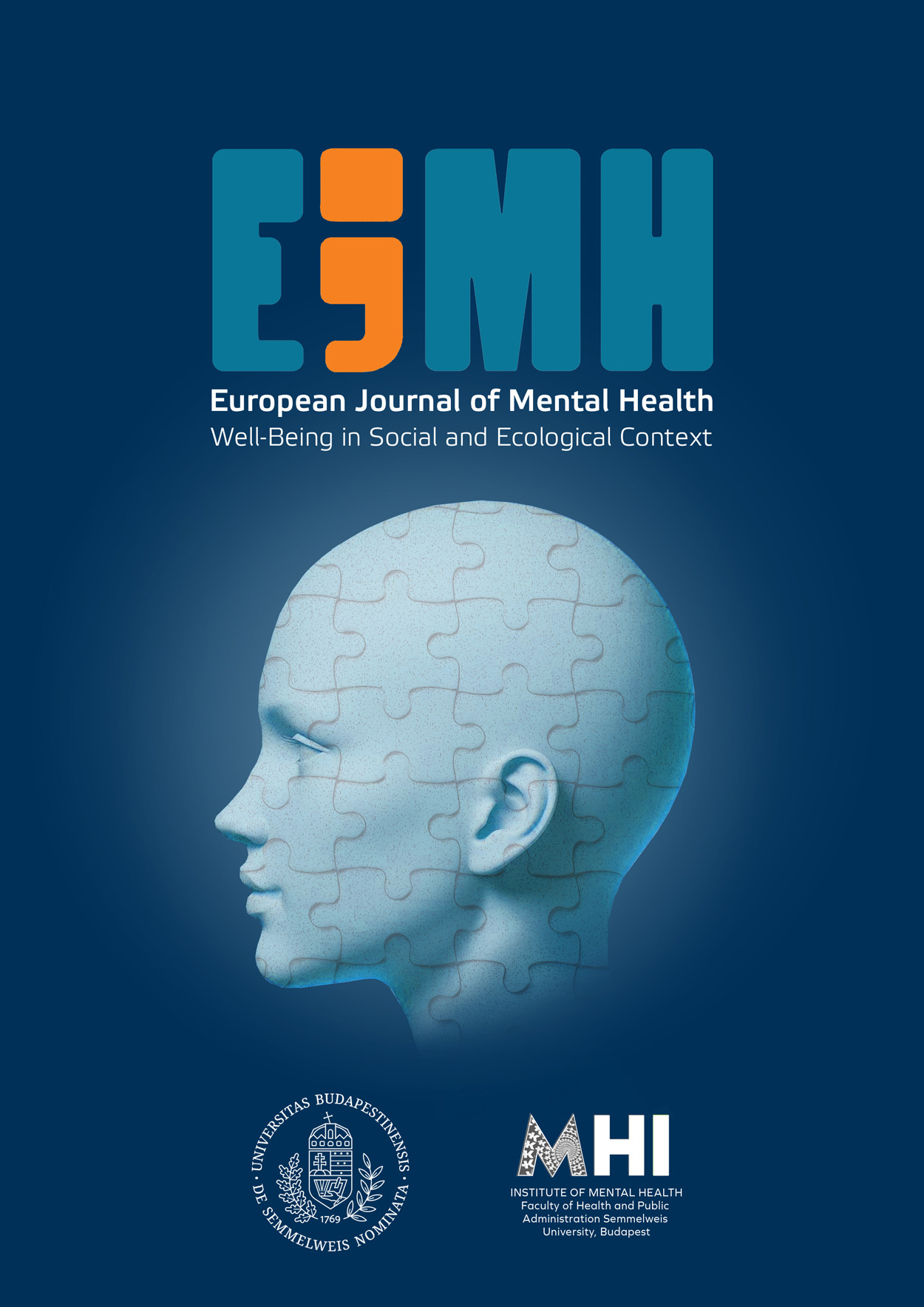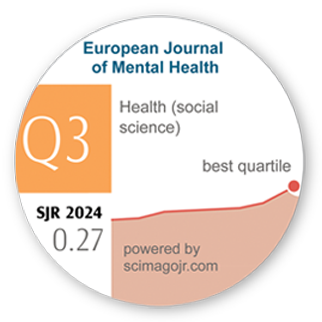Should I Move? The Benefits and Costs of Spatial Mobility for Different Groups of the Roma Population
DOI:
https://doi.org/10.5708/EJMH.18.2023.0010Keywords:
Roma groups, mental health, spatial mobility, weak ties, CDNAbstract
Introduction: Moving away can be motivated by a multitude of factors, just as the reasons for not moving away might be different. The individual’s social situation greatly determines the chance of turning their life situation around through moving away.
Aims: We investigated the factors that affected the representatives of the three Roma groups researched here (Romungro, Vlach, Boyash) in their moving in the past and in their intentions to move in the future.
Methods: A SEM model was developed (N = 570) to analyze the differences between previous movers and non-movers in well-being, socioeconomic status, and social network. We also investigated the effect of the above variables on the intention to move. Data were collected via the “snowball method”.
Results: Out of the Vlachs, those who had moved in the past have significantly fewer confidant relatives (p = .021) and also know significantly fewer people pursuing high-prestige vocations (p = .003), moreover, the fewer people pursuing moderate-prestige vocations they know, the more they would like to move away from their present residence (p = .031). Regarding the Boyash, the more favorable their socio-economic situation, the more they would like to move away (p = .007); while regarding the Romungro, the low level of their mental wellbeing (p = .019) and the relatively high number of their confidant relatives constitutes (p = .017) the incentive to change their residence.
Conclusions: The spatially mobile Roma who had moved before possess fewer confidant relatives and weak ties. The individual factors connect to the different Roma groups’ moving intentions to various extents.
References
Babusik, F. (2007). Magyarországi cigányság – strukturális csapda és kirekesztés [Hungarian Roma - structural trap and exclusion]. Esély, 1, 3–23.
Bálint, L., & Obádovics, Cs. (2021). Belföldi vándorlás [Inward migration]. In Monostori, J., Őri, P. & Spéder, Zs. (Eds.) (2021). Demográfiai portré 2021 [Demographic portrait 2021], 211–226. KSH NKI.
https://www.demografia.hu/kiadvanyokonline/index.php/demografiaiportre/article/view/2834/2724
Bernát, A. (2019). Integration of the Roma in Hungary in the 2010s. In I. G., Tóth (Ed.), Társadalmi riport 2019 [Social report 2019], 195–215. TÁRKI.
http://www.tarki.hu/sites/default/files/2019‐ 02/196_214_Bernat.pdf
Cahn, C., & Guild, E. (2008). Recent Migration of Roma in Europe. Council of Europe: Commissioner for Human Rights. Accessed 1 March 2010.
http://www.unhcr.org/refworld/docid/4a703c2a2.html
Chaudhuri-Brill, S. (2012). We Are No Longer Real: Discourses on Identity and Authenticity among Czech Roma. Ann Arbor, MI: UMI Dissertation Publishing (UMI number 3508981).
Connor, K. M., & Davidson, J. R. (2003). Development of a new resilience scale: The Connor‐Davidson resilience scale (CD‐RISC). Depression and Anxiety, 18(2), 76–82.
https://doi.org/10.1002/da.10113
Cseres-Gergely, Zs. (2013). Elméleti megfontolások a munkavállalók területi mozgásának okaival és eredményével kapcsolatban [Theoretical considerations on the causes and outcomes of territorial mobility of workers]. In Zs. Cseres-Gergely (Ed.), Közelkép. Munkaerőpiaci egyenlőtlenségek és földrajzi mobilitás Magyarországon [Close-up. Labour market inequalities and geographical mobility in Hungary], 51–56.
Cserti Csapó, T. (2003). A cigány népesség társadalmi-gazdasági helyzete a Dél-Dunántúlon [The socio-economic situation of the Roma population in South Transdanubia]. Ph.D. értekezés. Pécsi Tudományegyetem, Természettudományi Kar, Földrajzi Intézet, Pécs.
Csizmady, A., Győri, Á., Kőszeghy, L., & Rácz, A. (2020). Területi mobilitás és a magyar társadalom integrációs csoportjai [Territorial mobility and integration groups in Hungarian society]. In I., Kovách (Ed.), Mobilitás és integráció a magyar társadalomban [Mobility and integration in Hungarian society], 129-163. MTA Társadalomtudományi Kutatóközpont, Agumentum.
Dávid, B., Komolafe, C., Lukács, J. Á., Schutzmann, R., & Tóth, G. (2020). Hol vannak a testvérek? A roma barátságok alakulása 2004-ben és 2019-ben [Where are the siblings? Evolution of Roma friendships in 2004 and 2019]. Socio.hu, 10(3), 70–93.
https://doi.org/10.18030/socio.hu.2020.3.70
Diószegi J., Pikó P., Kósa Z., Sándor J., Llanaj E., & Ádány R. (2020). Taste and Food Preferences of the Hungarian Roma Population. Frontiers in Public Health, 8, 359, 1–11.
https://doi.org/10.3389/fpubh.2020.00359
Drukker, M., Gunther, N., & van Os, J. (2007). Disentangling associations between poverty at various levels of aggregation and mental health. Epidemioligai s Psichiatria Sociale, 16(1), 3–9.
https://doi.org/ 10.1017/S1121189X00004541
Durst, J. (2018). Out of the frying pan into the fire? From municipal lords to the global assembly lines – Roma experiences of social im/mobility through migration from North Hungary. Intersections. East European Journal of Society and Politics, 4(3), 4–28.
https://doi.org/10.17356/ieejsp.v4i3.479
Durst, J., & Nagy, V. (2018). Transitional Roma mobilities: The enactment of invisible resistance. Intersections. East European Journal of Society and Politics, 4(2), 3–16.
https://doi.org/10.17356/ieejsp.v4i2.466
Elekes, Gy. (2017). Közösség és tér. A térbeliség hatása a társadalmi identitásra Borsod és Baranya gettósodott térségeiben [Community and space. The impact of spatiality on social identity in the ghettoised areas of Borsod and Baranya]. Szociálpedagógia, 5(3–4), 78–90.
Elekes, Gy. (2021). A történelem kereke. A szóbeliség jelentősége perifériára szorult cigány közösségek életében [The wheel of history. The importance of the spoken language in the life of marginalised Roma communities]. Új Pedagógiai Szemle, 71(3-4), 13–34.
European Union Agency for Fundamental Rights (2022). Roma in 10 European countries.
https://fra.europa.eu/sites/default/files/fra_uploads/fra-2022-roma-survey-2021-main-results_en.pdf
Európai lakossági egészségfelmérés (European Health Interview Survey] (ELEF) (2019).
https://www.ksh.hu/docs/hun/xftp/idoszaki/elef/szubjektiv_jolet_2019/index.html
Fésüs G., Östlin P., McKee M., & Ádány R. (2012). Policies to improve the health and well-being of Roma people: the European experience. Health Policy 105(1), 25–32.
https://doi.org/10.1016/j.healthpol.2011.12.003
Forray, K. R. (2013). Cigány egészség, cigány betegség-Mitől betegebbek? [Roma health, Roma disease – What makes them sicker?]. Educatio, 22(2), 177–186.
Gordon, D. (2003). Area-based deprivation measures: a UK perspective. In Kawachi, I. & Berkman, L. F. (Eds.), Neighborhoods and health, 179–207. Oxford University Press.
Gödri, I. (2018). Nemzetközi vándorlás [International migration]. In Monostori, J., Őri, P. & Spéder, Zs. (Eds.), Demográfiai portré 2018 [Demographic portrait 2018], 237–270. Budapest: KSH Népességtudományi Kutatóintézet.
https://demografia.hu/kiadvanyokonline/index.php/demografiaiportre/article/view/2738/2651
Hautzinger, Z., Hegedüs, J., & Klenner, Z. (2014). A migráció elmélete [The theory of migration]. Nemzeti Közszolgálati Egyetem Rendészettudományi Kar. Budapest.
Havas, G. (1989). A cigány közösségek történeti típusairól [On the historical types of Gypsy communities]. Kultúra és Közösség, 16, 3–17.
Havasi, É., & Kóczé, A. (2010). Kutatási terep és módszertan bemutatása [Presentation of research area and methodology]. In Kóczé, A. (Ed.), Nehéz sorsú asszonyok feketén fehéren [Women with hardships in black and white], 7–18. MTA ENKI.
Husz, I. (2011). Alacsony végzettség – sok gyerek? A magas terménkenység néhány területi és etnikai aspektusáról [Low education - many children? Some spatial and ethnic aspects of high fertility]. Demográfia, 54(1), 5–22.
https://demografia.hu/kiadvanyokonline/index.php/demografia/article/view/465/563
Huszti, É., & Ember, Zs. (2019). Társas kapcsolatok és mentális egészség szegregált településrészeken [Social Relations and Mental Health in Segregated Settlement Parts]. Egészségfejlesztés, 60(5), 36–45.
https://ojs.mtak.hu/index.php/egfejl/article/view/10943/8809
Huszti, É., Albert, F., Csizmady, A., Nagy, I., & Dávid, B. (2021). When Spatial Dimension Matters: Comparing Personal Network Characteristics in Different Segregated Areas. Social Inclusion, 9(4), 375–387.
https://doi.org/10.17645/si.v9i4.4520
Janák, K. (Ed.) (2018). Mikrocenzus 2016. A foglalkozésok presztízse [Microcensus 2016. The prestige of occupations]. KSH.
Janky, B., & Kemény, I. (2004). Települési és lakásviszonyok [Municipal and housing conditions]. Beszélő, 4, 96–110.
Kahl, T., & Nechiti, I. (2019). The Boyash in Hungary. A Comparative Study Among the Argeleni and Munceni Communities. Verlag der ÖAW.
Kemény, I. (2000). A magyarországi romák [The Roma in Hungary]. Változó világ, 31.
Kemény, I. (Ed.) (2005). Roma of Hungary. Boulder, CO, Columbia University Press.
Kemény, I., & Janky, B. (2005). Roma Population of Hungary 1971-2003. In Kemény, I. (Ed.) Roma of Hungary, 70–225. Atlantic Research and Publication, Highland Lakes.
Kincses, Á. (2014). Nemzetközi migrációs körkép Magyarországról a 2011-es népszámlálási adatok alapján [International migration profile of Hungary based on 2011 census data]. Területi Statisztika, 54(6), 590–605.
Kiss, Cs., Vajda, D., Káplár, M., Csókási, K., Hargitai, R., & Nagy, L. (2015). A 25-itemes Connor—Davidson Rezíliencia Skála (CD-RISC) magyar adaptációja [Hungarian adaptation of the 25-item Connor-Davidson Resilience Scale (CD-RISC)]. Mentálhigiéné és Pszichoszomatika, 16(1), 93–113.
https://doi.org/10.1556/Mental.16.2015.1.4
Kleinhans, R. (2009). Does social capital affect residents' propensity to move from restructured neighbourhoods? Housing Studies, 24(5), 629–651.
https://doi.org/10.1080/02673030903085784
Komolafe, C., Lukács J. Á., Szabó, T., & Pethesné D. B. (2022). A barátok szerepe a roma egyetemisták társadalmi mobilitásában és beilleszkedésében [The role of friends in the social mobility and integration of Roma students]. Máltai Tanulmányok, 4(2), 69–81.
https://www.researchgate.netpublication/362517943
Kopp, M., & Martos, T. (2011). A társadalmi összjóllét jelentősége és vizsgálatának lehetőségei a mai magyar társadalomban I. Életminőség, gazdasági fejlődés és a Nemzeti Összjólléti Index [The significance of societal well-being and the possibility of its research in the contemporary Hungarian society I. Quality of life, economic growth, and the National Well-being Index]. Mentálhigiéné és Pszichoszomatika, 12(3), 241–259.
https://doi.org/10.1556/Mental.12.2011.3.3
Kovács, Á. (2014). A romák egészségi állapota és a szolgáltatásokhoz való hozzáférésük [The health status of Roma and their access to services]. In Vizi, B. (Ed.), A romapolitikák értékelési módszerei és a magyar kormányzatok romapolitikái [Evaluation methods of Roma policies and Roma policies of Hungarian governments], 37–45. Nemzeti Közszolgálati Egyetem.
Kósa, K., & Bíró, É. (2018). A mentális állapot populációs szintű vizsgálatának koncepciói és eszközei [Concepts and tools for population-level assessment of mental health]. Mentálhigiéné és Pszichoszomatika, 19(2), 103–139.
https://doi.org/10.1556/0406.19.2018.005
Kósa Zs. (2006). Telepszerű körülmények között élők egészségfelmérése [Health assessment of people living in settled conditions]. Egyetemi doktori (PhD) értekezés [University doctoral thesis (PhD)]. Debreceni Egyetem Orvos- és Egészségtudományi Centrum Népegészségügyi Iskola, Debrecen.
Központi Statisztikai Hivatal (KSH). (2014). 2011. Évi népszámlálás. 9.: Nemzetiségi adatok [2011 census. 9: Minority data].
https://www.ksh.hu/docs/hun/xftp/idoszaki/nepsz2011/nepsz_09_2011.pdf
Központi Statisztikai Hivatal (KSH). (2016). Miben élünk—A 2015. Évi lakásfelmérés főbb eredményei [Where do we live—Main results of the housing survey in 2015].
https://www.ksh.hu/docs/hun/xftp/idoszaki/pdf/miben_elunk15.pdf
Központi Statisztikai Hivatal (KSH). (2021). A fenntartható fejlődés indikátorai [Indicators of sustainable development].
https://ksh.hu/s/kiadvanyok/fenntarthato-fejlodes-indikatorai-2022/4-2
Kroenke, K., Spitzer, R. L., & Williams, J. B. (2001). The PHQ‐9: validity of a brief depression severity measure. Journal of General Internal Medicine, 16(9), 606–613.
https://doi.org/10.1046/j.1525-1497.2001.016009606.x
Ladányi, J., Csanádi, G., Csepeli, G., Szelényi, I., & Nemeskéry, A. (2010). 2. Társadalom és térszerkezeti átalakulások: Válogatott tanulmányok (1975–2010): A gazdasági élet szociológiája [Society and spatial transformations: selected papers (1975–2010): the sociology of economic life].
Messing, V. (2006): Lyukakból szőtt háló: Háztartások közötti támogató kapcsolatok roma és nem roma szegények körében [A web of holes: supportive relationships between households among Roma and non-Roma poor]. Szociológiai Szemle, 16(2), 37–54.
Messing, V. & Molnár, E. (2011). Bezáródó kapcsolati hálók: szegény roma háztartások kapcsolati jellemzői [Closing networks: relational characteristics of poor Roma households]. Esély, (5), 47–74.
Nunes, M.A., Kučerová, K., Lukáč, O., Kvapil, M., & Brož, J. (2018). Prevalence of Diabetes Mellitus among Roma Populations—A Systematic Review. International Journal of Environmental Research Public Health, 15(11), Article 2607.
https://doi.org/10.3390/ijerph15112607
Parliament Office – Directorate for Public Collections and Culture Information Service for Members of Parliament [Országgyűlés Hivatala – Közgyűjteményi és Közművelődési Igazgatóság Képviselői Információs Szolgálat] (2022). Európai romapolitika: a romák egészségi állapota. Infojegyzet. 32. [European Roma policy: the health of Roma. Info note. 32.]
Pásztor, Z. I., Pénzes, J., Tátrai, P., & Pálóczi, Á. (2016). The number and spatial distribution of the roma population in Hungary - in the light of different approaches. Folia geographica. Acta facultatis studiorum humanitatis et naturae Universitatis Prešoviensis, Prírodné vedy 58(2), 5-21. FHPV PU Prešov.
Pénzes, J., Tátrai, P., & Pásztor, I. Z. (2018). A roma népesség területi megoszlásának változása magyarországon az elmúlt évtizedekben [Changes in the spatial distribution of the Roma population in Hungary during the last decades]. Területi statisztika, 58(1), 3–26.
https://doi.org/10.15196/TS580101
Sik, E. (2003). A migrációs potenciál kutatásának alapfogalmai. In Örkény, A. (Ed.) Menni vagy maradni? Kedvezménytörvény és migrációs várakozások [To go or to stay? Benefit law and migration expectations]. 15–18. MTA Kisebbségkutató Intézet.
Solymosy, J. B. (2007). A romák egészségi állapota Magyarországon [The health status of Roma in Hungary]. In Egyenlőség, egészség és a roma/cigány közösség [Equality, health and the Roma/Gipsy community]. 28–55. Fundación Secretariado Gitano.
Subramanian, S. V., Jones, K., & Duncan, C. (2003). Multilevel methods for public health research. In Kawachi, I. & Berkman, L. F. (Eds.), Neighborhoods and Health, 65–111. Oxford University Press.
Susánszky, É., Konkolÿ-Thege, B., Stauder, A., & Kopp, M. (2006). A WHO Jól-lét Kérdőív rövidített (WBI-5) magyar változatának validálása a Hungarostudy 2002 országos lakossági egészségfelmérés alapján [Validation of the shortened (WBI-5) Hungarian version of the WHO Well-Being Questionnaire based on the Hungarostudy 2002 national population health survey]. Mentálhigiéné és Pszichoszomatika, 7(3), 247–255.
https://doi.org/10.1556/mental.7.2006.3.8
Szabóné Kármán, J. (2008). A roma/cigány népesség helyzete [The situation of Roma/Gypsy population]. In Kopp Mária (Ed.) Magyar lelkiállapot [Hungarian state of mind], 415–427. Semmelweis Kiadó.
Szabóné Kármán, J. (2018). A magyarországi cigány/roma népesség kultúrantropológiai és orvosantropológiai megközelítésben [The Gypsy/Roma population in Hungary in a cultural anthropological and medical anthropological approach]. Romológiai füzetek, 2 [Romology booklets, 2.], 45–50.
Teller, R. (2011). Adaptációs csapdák. Hipotézisek a romák lakásmobilitásáról a 2010-es adatfelvétel lakásváltoztatási kérdéseire adott válaszok és a korábbi cigányfelvételek lakásmobilitási adatai alapján [Adaptation traps. Hypotheses on Roma housing mobility based on the responses to the housing change questions of the 2010 survey and on housing mobility data from previous Gypsy surveys]. In Kurucz, E. (Ed.) Roma kutatások, 2010 – Élethelyzetek a társadalom peremén [Researches on Roma, 2010 – Life situations on the margins of society], 203–218. Nemzeti Család és Szociálpolitikai Intézet.
Topp, C. W., Østergaard, S. D., Søndergaard, S., & Bech, P. (2015). The WHO-5 Well-Being Index: a systematic review of the literature. Psychotherapy and Psychosomatics, 84(3), 167–176.
https://doi.org/10.1159/000376585
Torzsa, P., Szeifert, L., Dunai, K., Kalabay, L., & Novák, M. (2009). A depresszió diagnosztikája és kezelése a családorvosi gyakorlatban [Diagnosis and treatment of depression in family medicine practice]. Orvosi Hetilap, 150(36), 1684–1693.
https://doi.org/10.1556/OH.2009.28675
Virág, T. (2018). A kapcsolathálózatok szerepe a migrációban egy cigányfalu perspektívájából [The role of contact networks in migration from the perspective of a Gypsy village]. Socio.hu, 8(1), 163–179.
https://doi.org/10.18030/socio.hu.2018.1.163
Virág T., & Váradi M. M., (2017). Spatial Exclusion and Boundary-Making in Different Roma Neighbourhoods in Hungarian Rural Small Towns. Tijdschrift voor economische en sociale geografie, 109(4), 1–14.
https://doi.org/10.1111/tesg.12300
Zeman, C. L., Depken, D. E., & Senchina, D. S. (2003). Roma health issues: a review of the literature and discussion. Ethnicity & Health, 8(3), 223–249.
https://doi.org/10.1080/1355785032000136434
Wacquant, L. (2012). A Janus-faced institution of ethnoracial closure: A sociological specification of the ghetto. In R. Hutchison & B.D., Haynes (Eds.), The ghetto: Contemporary global issues and controversies, 1–32. Boulder CO, Westview.
Winter, L., Lawton, M. P., Langston, C. A., Ruckdeschel, K., & Sando, R. (2007). Symptoms, affects, and self-rated health. Evidence for a subjective trajectory of health. Journal of Aging and Health, 19, 453–469.
https://doi.org/10.1177/0898264307300167






